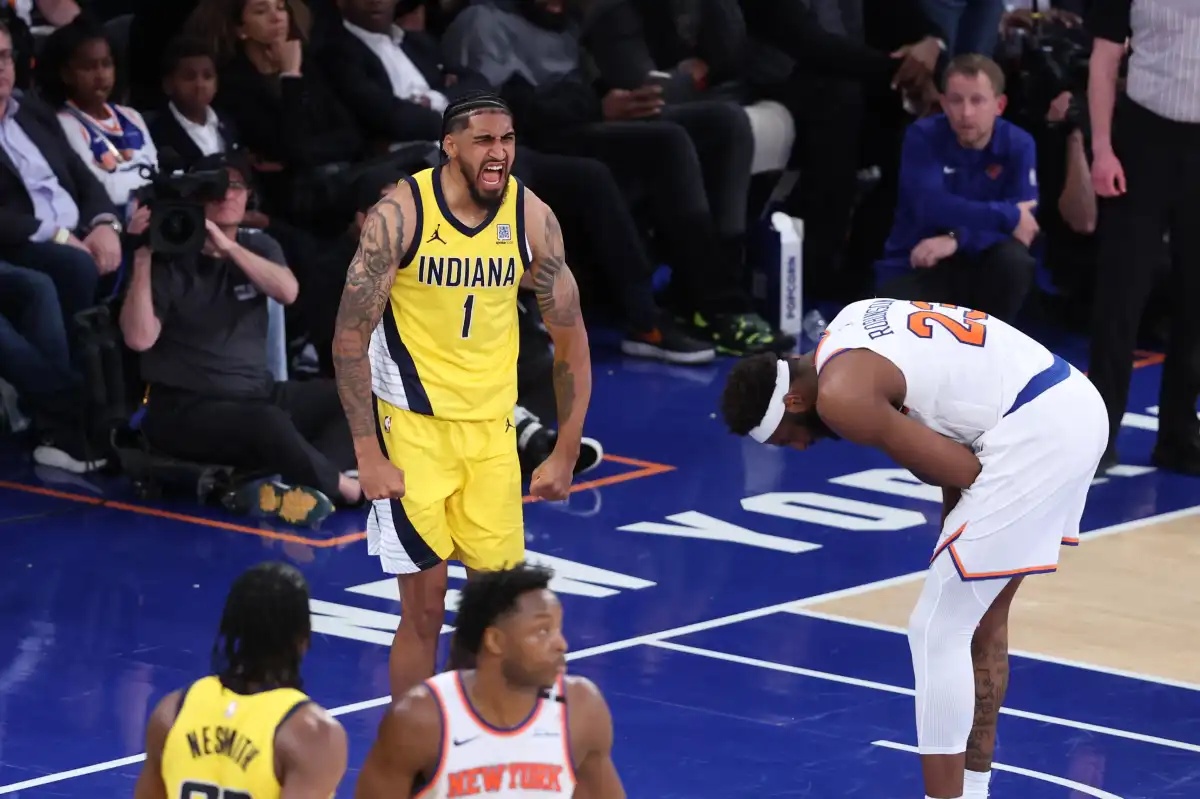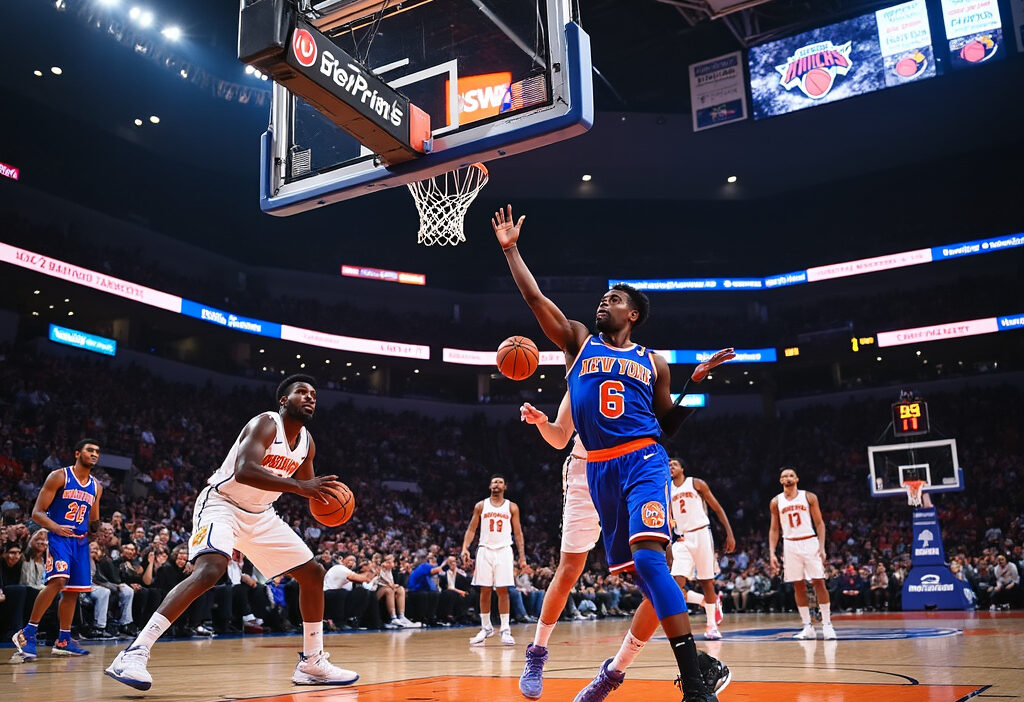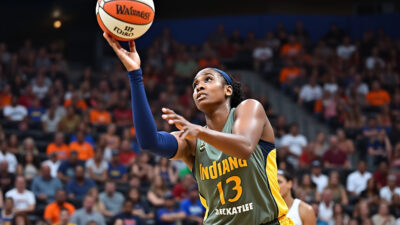Knicks’ Overtime Heartbreak: A Game 1 Breakdown Against the Pacers
On May 21, 2025, the New York Knicks faced a bitter defeat in Game 1 of the Eastern Conference Finals against the Indiana Pacers, despite leading the game comfortably in the fourth quarter. This article delves into the factors contributing to their historic collapse, attempting to understand how a game that seemed well in their favor slipped away, catapulting the Pacers to a dramatic 138-135 overtime victory.
The Stage Set for a Classic
The New York Knicks and Indiana Pacers entered Game 1 of the Eastern Conference Finals with the weight of history on their shoulders. For the Knicks, this was their first trip to the conference finals since 2000, a painful 24-year drought for a franchise synonymous with basketball royalty. The Pacers, meanwhile, hadn’t reached this stage since 2014, when Paul George led them to back-to-back conference finals appearances. The stakes were sky-high—both teams hungry to prove they belonged among the NBA’s elite after years of rebuilding and near-misses.
This matchup also revived a fierce playoff rivalry from the 1990s, when Reggie Miller’s Pacers and Patrick Ewing’s Knicks clashed in multiple classic series, including the 1994 and 1995 Eastern Conference Finals. Those battles defined an era of physical, defense-first basketball. Now, decades later, a new generation sought to carve its own legacy. For the Knicks, led by Jalen Brunson and a resilient supporting cast, this was a chance to exorcise decades of postseason demons. For the Pacers, with Tyrese Haliburton orchestrating their high-octane offense, it was an opportunity to announce their return as contenders.
The stage was set for a classic—two teams with contrasting styles, rich histories, and desperate fanbases. The Knicks leaned on their trademark grit and defense, while the Pacers thrived on pace and ball movement. Both teams had overcome adversity to get here: the Knicks surviving a grueling seven-game series against the Pacers in the second round, while Indiana upset the top-seeded Celtics. The energy in Madison Square Garden was electric, a mix of nostalgia and newfound hope. One thing was certain: neither team would go down without a fight.
The Game That Was Almost Won
The New York Knicks appeared poised to seize control of Game 1 against the Indiana Pacers, dominating large stretches of the contest before their late unraveling. For three quarters, Madison Square Garden buzzed with energy as the Knicks executed their game plan with precision, building a lead that reached as high as 12 points in the third quarter. Jalen Brunson was the catalyst, continuing his playoff brilliance with a masterful scoring display, finishing the first half with 25 points on efficient shooting. His ability to penetrate the Pacers’ defense and create opportunities for teammates kept Indiana on its heels.
The Knicks’ supporting cast also delivered. Donte DiVincenzo provided timely three-point shooting, while Isaiah Hartenstein anchored the interior with relentless rebounding and rim protection. The team’s defensive intensity disrupted the Pacers’ usually high-powered offense, forcing contested shots and limiting transition opportunities. New York’s physicality and hustle plays—like Josh Hart’s trademark offensive rebounds—gave them extra possessions, allowing them to maintain momentum.
Even as the Pacers made small runs, the Knicks responded each time, showcasing the resilience that had carried them this far. A 10-2 spurt late in the third quarter, capped by a Brunson step-back three, seemed to solidify their grip on the game. The crowd roared, sensing a statement victory. Yet, despite their control, cracks began to show. Fatigue set in, and the Pacers adjusted, tightening their defense and pushing the tempo. The Knicks’ once-fluid offense grew stagnant, foreshadowing the collapse that would follow—a topic explored in the next chapter. But for most of the night, this was their game to lose.
The Fourth Quarter Collapse
The New York Knicks’ late-game collapse in Game 1 against the Pacers was a brutal lesson in momentum shifts and execution under pressure. After dominating for three quarters, the Knicks unraveled in the final minutes, surrendering a double-digit lead due to a combination of self-inflicted mistakes and defensive breakdowns. The most glaring issue was their inability to handle Indiana’s increased defensive intensity, leading to critical turnovers that fueled the Pacers’ transition game. Jalen Brunson, who had been stellar earlier, committed two costly giveaways in the last four minutes, including a dribble into traffic that resulted in a fast-break layup for Tyrese Haliburton.
Offensively, the Knicks went cold at the worst possible time. Their shot selection deteriorated, with rushed threes and contested mid-range attempts replacing the disciplined ball movement that had built their lead. Julius Randle, despite a strong overall performance, missed a key open jumper with under two minutes left, while Josh Hart—usually reliable in clutch moments—failed to convert a driving layup that would have stemmed the Pacers’ momentum. These missed opportunities compounded the pressure on a defense that was already buckling.
Defensively, the Knicks’ communication faltered, particularly in containing dribble penetration. Haliburton and Aaron Nesmith exploited mismatches, with Nesmith’s shooting sparking the comeback (a theme explored in the next chapter). The Knicks also struggled to secure defensive rebounds, allowing multiple second-chance points in crunch time. Coach Tom Thibodeau’s usually airtight system showed cracks, as rotations were late and closeouts lacked urgency. The collapse wasn’t just about one play—it was a cascade of errors that handed the Pacers a lifeline they eagerly seized.
Aaron Nesmith’s Historic Shooting
Aaron Nesmith’s Historic Shooting
The Pacers’ comeback in Game 1 was fueled by an unexpected hero: Aaron Nesmith. While the Knicks’ defensive lapses in the fourth quarter set the stage, it was Nesmith’s historic three-point barrage that shifted the game’s momentum irreversibly. The Pacers forward went 5-for-5 from beyond the arc in the final period, a performance that not only tied a playoff record but also demoralized a Knicks team that had controlled the game for three quarters.
Nesmith’s shooting wasn’t just efficient—it was timely. Each of his threes came at critical junctures, either halting a potential Knicks run or extending the Pacers’ own offensive surge. His first three cut the deficit to single digits, while his fourth tied the game, erasing what had once been a 12-point lead. The fifth, a contested shot over a closing defender, gave Indiana its first lead since the opening quarter, sending shockwaves through Madison Square Garden.
What made Nesmith’s performance even more remarkable was its rarity. Before this game, he had been a streaky shooter, averaging just 36% from deep in the regular season. Yet, under playoff pressure, he delivered with near-perfect precision. The Knicks, who had prioritized containing Tyrese Haliburton and Pascal Siakam, were caught off guard by Nesmith’s eruption. Their late-game adjustments came too late, as defensive rotations failed to account for his sudden offensive explosion.
By the time overtime arrived, Nesmith’s shooting had already rewritten the narrative of the game. His performance wasn’t just a footnote—it was the catalyst that turned a potential Knicks victory into a heartbreaking collapse, setting the stage for Haliburton’s dramatic tying shot moments later.
The Tying Shot
The tension inside Madison Square Garden was palpable as the clock ticked down to the final seconds of regulation. With the Knicks clinging to a narrow lead, the Pacers’ Tyrese Haliburton seized control of the moment. The play was a masterclass in execution—Haliburton, cool under pressure, used a screen from Myles Turner to create just enough separation from Jalen Brunson. As Brunson fought through the pick, Haliburton stepped back, his feet perfectly set behind the arc, and released a high-arcing three-pointer. The ball seemed to hang in the air for an eternity before swishing through the net with 12.7 seconds left, tying the game at 117-117.
The Garden, which had been roaring moments earlier, fell into stunned silence. Haliburton, ever the showman, turned to the crowd with a smirk, soaking in the disbelief. On the Knicks’ bench, Tom Thibodeau clenched his jaw, his defensive schemes unraveled at the worst possible moment. The Pacers’ bench erupted, their energy surging after clawing back from a double-digit deficit. The Knicks, who had controlled much of the fourth quarter, now faced an overtime battle they hadn’t anticipated.
New York’s final possession in regulation fizzled out—Brunson’s contested fadeaway clanked off the rim, a microcosm of their late-game struggles. The Pacers, meanwhile, had executed when it mattered most. Haliburton’s shot wasn’t just a tying basket; it was a psychological dagger, shifting momentum entirely. The Knicks’ body language betrayed their frustration, while Indiana played with the confidence of a team that had stolen the momentum. As overtime loomed, the question wasn’t just about X’s and O’s—it was about which team could recover mentally from a moment that would define Game 1.
Overtime Battle
The overtime period in Game 1 was a stark contrast to the Knicks’ gritty fourth-quarter effort, as fatigue and execution lapses allowed the Pacers to seize control. Tyrese Haliburton, who had just tied the game with a clutch three, carried his momentum into the extra frame, orchestrating Indiana’s offense with precision. His back-to-back assists to Pascal Siakam for mid-range jumpers gave the Pacers an early four-point lead, forcing New York into a reactive stance.
The Knicks’ offense, which had relied heavily on Jalen Brunson all night, sputtered in overtime. Brunson, visibly exhausted, missed two critical shots and committed a costly turnover under pressure from Andrew Nembhard. Meanwhile, Josh Hart, who had been a rebounding force all game, fouled out with 2:34 remaining, stripping the Knicks of their energy and defensive versatility.
Indiana capitalized on New York’s miscues, with Myles Turner sinking a dagger three-pointer off a broken play, extending the lead to six. The Knicks’ defensive rotations, usually airtight under Tom Thibodeau, were a step slow, leaving shooters open. Donte DiVincenzo tried to spark a comeback with a driving layup, but the Pacers’ disciplined switching neutralized any late surge.
The final nail came when Siakam stripped Brunson on a drive, leading to a fast-break dunk by Aaron Nesmith that sealed the game. The Knicks’ late collapse wasn’t just about missed shots—it was a breakdown in focus and stamina, areas they’ll need to address before Game 2. The Pacers, meanwhile, showcased their depth and poise, proving they could thrive under playoff pressure.
Coach Thibodeau’s Analysis
In the aftermath of the Knicks’ overtime collapse, head coach Tom Thibodeau didn’t mince words in his postgame analysis. “We lost our edge when it mattered most,” he admitted, pinpointing defensive lapses and untimely turnovers as the primary culprits. Thibodeau, known for his defensive-minded approach, expressed frustration with the team’s inability to contain the Pacers’ late-game surge, particularly in transition. “Our rotations were slow, and we gave up too many easy baskets,” he said, highlighting how Indiana exploited New York’s fatigue in critical moments.
Thibodeau also emphasized the Knicks’ 19 turnovers, which led to 24 Pacers points. “You can’t win playoff games giving the ball away like that,” he stated, singling out unforced errors and rushed decisions under pressure. While he credited the Pacers’ defensive intensity, he stressed that many of the mistakes were self-inflicted, including ill-advised passes and poor shot selection down the stretch. The coach’s tone suggested a rare lapse in the discipline he typically demands from his team.
When asked about adjustments, Thibodeau hinted at tightening the rotation and reinforcing defensive fundamentals. “We have to clean up the details—boxing out, closing out, taking care of the ball,” he said, signaling a return to basics ahead of Game 2. His remarks aligned with the Knicks’ identity as a gritty, defensive squad, making the late breakdown all the more uncharacteristic. The challenge now, as the series progresses, is whether New York can rediscover its trademark toughness or if the Pacers have exposed a crack in their armor.
Learning from Loss
The Knicks’ Game 1 collapse against the Pacers wasn’t just a tactical failure—it was a mental one. Players admitted to a late-game letdown, with Jalen Brunson acknowledging “we lost our edge when it mattered most.” This admission highlights the psychological toll of playoff basketball, where momentum shifts can derail even the most disciplined teams. Sports psychologists emphasize the need for resilience frameworks in high-pressure scenarios. Dr. Carla Greubel, a performance specialist, notes, “Playoff losses like this require immediate cognitive reframing. Teams must dissect mistakes without letting them define the series.”
Tactically, the Knicks must address their late-game execution. While Thibodeau pinpointed turnovers and defensive lapses earlier, the deeper issue was decision fatigue. New York’s reliance on isolations in crunch time—a strength during the regular season—left them predictable. NBA analyst Kirk Goldsberry suggests, “The Pacers exploited the Knicks’ stagnant offense by loading up on Brunson. Incorporating more off-ball movement and secondary playmakers like DiVincenzo could prevent defensive overloads.” Additionally, the bench’s limited contributions (just 11 points) forced starters into heavy minutes, compounding fatigue.
- Mental reset: Film sessions should focus on late-game positives (e.g., their 12-0 run in regulation) to rebuild confidence.
- Rotation tweaks: Integrating McBride or Burks for fresh legs could mitigate fourth-quarter exhaustion.
- Pace management: Indiana’s transition game thrived in OT; the Knicks must control tempo through deliberate half-court sets.
History shows playoff-tested teams rebound from such losses. The 2013 Heat, after a similar Game 1 OT collapse against the Spurs, adjusted by prioritizing ball movement and won the title. For the Knicks, this loss isn’t a death knell—it’s a teachable moment. As Brunson put it, “We’ll be better because of this.” The key lies in marrying tactical adjustments with the psychological fortitude to embrace adversity.
Looking Ahead to Game 2
The stakes for the Knicks in Game 2 couldn’t be higher. After surrendering a late lead in Game 1, they now face the risk of heading to Indiana down 0-2—a deficit no team wants in a best-of-seven series. Madison Square Garden must become a fortress, with the crowd’s energy fueling a more disciplined performance. The Knicks have thrived at home this postseason, and protecting that advantage is non-negotiable. A loss here would not only shift momentum but also amplify the pressure on a roster already battling fatigue and injuries.
Adjustments will be key. The Pacers exposed New York’s late-game execution, particularly in transition defense and shot selection. Expect the Knicks to tighten their rotations, prioritize ball security, and lean harder on Jalen Brunson to control the tempo. Coach Tom Thibodeau emphasized the need for smarter decisions in crunch time, hinting at possible lineup tweaks to counter Indiana’s speed. “We have to be sharper,” he admitted postgame, acknowledging the Pacers’ ability to capitalize on mental lapses.
- Defensive intensity: The Knicks must disrupt Tyrese Haliburton’s rhythm early, forcing him into contested shots rather than letting him orchestrate.
- Pace management: Slowing the game down could neutralize Indiana’s transition offense, a weakness New York failed to exploit in Game 1.
- Bench production: With key players logging heavy minutes, contributions from role players like Miles McBride or Precious Achiuwa could be the difference.
Game 2 isn’t just about redemption—it’s about proving the Knicks can adapt under playoff pressure. The Garden will be electric, but the team must channel that energy into a cleaner, more composed performance. If they falter again, the series could slip away before it even reaches the Hoosier State.
The Bigger Picture
The Knicks’ overtime loss in Game 1 wasn’t just a single-game stumble—it was a moment that could define their entire playoff run. For a team that has fought through injuries, fatigue, and doubt to reach the Eastern Conference Finals, this collapse carries weight beyond the box score. The Pacers, often underestimated, seized the opportunity to plant their flag, proving they’re not just happy to be here. The legacy implications are stark: for New York, it’s about shaking off decades of near-misses and proving they belong among the elite. For Indiana, it’s about validating their rebuild and announcing themselves as a force.
Fans felt the sting of this loss deeper than most. The Knicks’ late-game mistakes—missed free throws, defensive lapses—were magnified by the stage. Madison Square Garden, a cathedral of basketball hope, was poised to erupt, only to fall silent. The Pacers, meanwhile, fed off that energy, turning doubt into momentum. This game wasn’t just about adjustments or Xs and Os; it was about which team could handle the pressure of legacy. The Knicks have thrived as underdogs, but now they’re expected to deliver. The Pacers, playing with house money, have nothing to lose.
Looking ahead, this series hinges on resilience. The Knicks must prove they can bounce back, or risk letting one loss spiral into a defining failure. The Pacers, if they steal Game 2, could shift the narrative entirely. For New York, the margin for error is razor-thin—every possession, every rebound, every second matters. The bigger picture isn’t just about this game; it’s about whether this Knicks team can cement itself in franchise lore or become another what-if.

Conclusions
The Knicks’ Game 1 loss to the Pacers was a harrowing reminder of the unpredictability of playoff basketball. Despite their commanding lead, critical errors in the closing minutes highlighted areas needing immediate attention. As the series progresses, the Knicks face the challenge of bouncing back and rectifying the mistakes that cost them dearly, with hopes of rewriting their narrative in future games.



